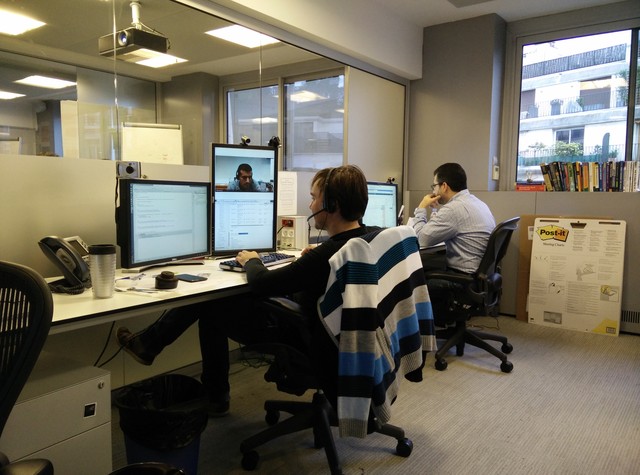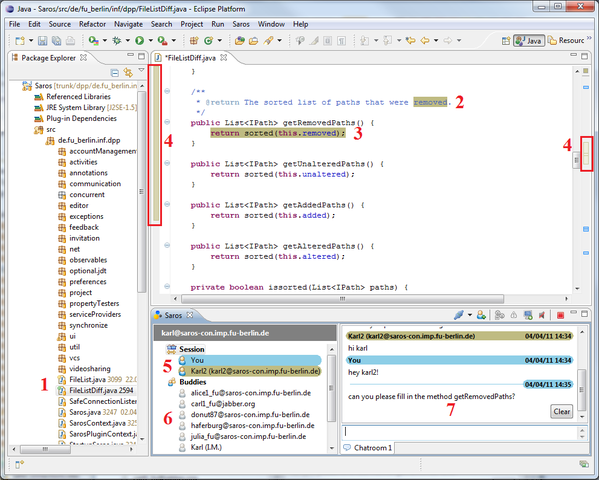From Zero to Pair Programming Hero
In my team at Murex, we’ve been doing Pair programming 75% of our time for the past 9 months now.
Before I explain how we got there, let’s summarize our observations :
- No immediate productivity drop
- Pair programming is really tiring
- Quality expectations throughout the team soared up
- As a result, the quality actually increased a lot
- But existing technical debt suddenly became incompatible with the team’s own quality criterion. We went on to pay it back, which slowed us down for a while
- Productivity is regularly going up as the technical debt is reduced
- It helped us to define shared coding conventions
- Pair programming is not for everyone. It has likely precipitated the departure of one team member
- It certainly helped the team to jell
- Newcomers can submit code on day 1
- The skills of everyone increase a lot quicker than before
- Bonus : it improves personal skills of all the team members
If you are interested in how we got there, read on, here is our story :
Best Effort Code Reviews
At the beginning, only experienced team members were reviewing the submitted code, and making remarks for improvement over our default review system : Code Collaborator.
This practice revealed tedious, especially with large change lists. As it was not systematic, reviewers constantly had to remind to the reviewees to act on the remarks, which hindered empowerment.
Systematic Code Reviews
Observing this during a retrospective, we decided to do add code review to our Definition Of Done. Inspired by best practices in the Open Source world, we created a ruby review script that automatically creates Code Collaborator reviews based on the Perforce submits. Everyone was made observer of any code change, and everyone was to participate in the reviews.
At first, to make this practice stick, a few benevolent review champions had to comment all the submitted code; once the habit was taken, everyone participated in the reviews.
Code Collaborator spamming was certainly an issue, but using Code Collaborator System Tray App helped each of us to keep up to date with the remaining reviews to do.
Bonus : As everyone was doing reviews, and that reviews of small changes are easier, submits became smaller.
This was certainly an improvement, but it remained time consuming. We believed we could do better.
Pair Programming
After 1 or 2 months of systematic code reviews, during a retrospective (again) nearly all the team members decided to give pair programming a try.
We felt the difference after the very first day : pair programming is intense, but the results are great. We never turned back.
With pair programming in place, we had to settle a pair switching frequency. We started with the full story, tried a one day rotation, and eventually settled on “MIN(1 week, the story)”.
This is not set in stone and is team dependent. It may vary depending on the learning curve required to work on a story. We might bring it down later maybe.
Remote Pair Programming
Ahmad, a Murex guy from Beirut joined the team a few months ago. We did not want to change our way of working, and decided to try remote pair programming.
Initial Setup
At the beginning, we were using Lync (Microsoft’s chat system) with webcams, headphones and screen sharing. It works, but Lync’s screen sharing does not allow seamless remote control between Paris and Beirut. Here is how we coped with this :
- Only exceptionally use Lync’s “Give Control” feature : it lags too much
- Do small submits, and switch control at submits
- When you cannot submit soon, shelve the code on perforce (you would just pull your buddy’s repo with git), and switch control
As a result, Ahmad became productive a lot more quickly. We are not 2 sub teams focusing on their own area of expertise, but 1 single distributed team sharing everything.
Improved Setup
Remote pair programming as such is workable, but does not feel as easy as being collocated. Here are a few best practices we are now using to improve the experience :
- Keep your pair’s video constantly visible : either on your laptop of in a corner of you main screen, but it’s important to see his facial expression all the time
- In order to allow eye contact, place your cam next to the window containing the video of your pair.
- Using 2 cameras, ManyCams and a small whiteboard allows to share drawings !
- We started using the Pomodoro technique for control switching. MarinaraTimer provides an online and shareable timer.
- We also started maintaining a todo list with an online shareable editor such as CollabEdit or Google Docs.
Future Setup
We are currently welcoming a new engineer in Beirut, and as we will be doing more remote pair programming, we’ll need to make this more seamless. Control sharing and lag through Lync remain the main issues. We don’t have a solution for that yet, but here are the fixes we are looking into
- Saros is an Eclipse plugin for remote concurrent and real time editing of files. Many people can edit the files at the same time. We are waiting for the Intellij version that is still under development
- Floobits is a commercial equivalent of saros. We tried it and it seems great. It’s not cheap though, especially with in-house servers.
- Screenhero is a commercial low-lag, multi cursor screen sharing tool. Unfortunately, it currently does not work behind a proxy, and so we were not able to evaluate it yet.
Final thoughts
I believe that collocated, and remote, pair programming are becoming key skills for a modern software engineer.
I hope this will help teams envisioning pair programming. We’d love to read about your best practices as well !








Leave a comment